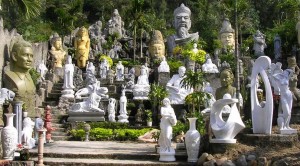
200 km north of NhaTrang is a small city named Quy Nhon. It is a beautiful beach city very similar to NhaTrang except there is almost no tourism. There is one place run by a New Zealander, but mostly there are no foreigners to be seen. The city has a large shopping mall and many Karaoke bars. It is also a very peaceful place to spend a little relaxation time on a quiet beach. Do not expect many tourist related activities. We fall asleep and wake up in Hoi An.
Again… thanks for the information I have borrowed from other sites
Hoi An:
The ancient town of Hoi An, 30 km south of Danang, lies on the banks of the Thu Bon River. Occupied by early western traders, Hoi An was one of the major trading centers of Southeast Asia in the 16th
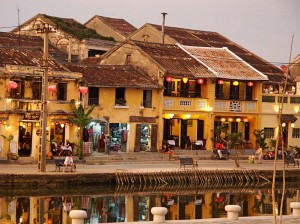
century. Hoi An has a distinct Chinese atmosphere with low, tile-roofed houses and narrow streets; the original structure of some of these streets still remains almost intact. All the houses were made of rare wood, decorated with lacquered boards and panels engraved with Chinese characters. Pillars were also carved with ornamental designs.Tourists can visit the relics of the Sa Huynh and Cham cultures. They can also enjoy the beautiful scenery of the romantic Hoi An River, Cua Dai Beach, and Cham Island.Over the last few years, Hoi An has become a very popular tourist destination in Vietnam..
My Son is the major site in Vietnam from the ancient Champa Kingdom which flourished between the 2nd and 15th centuries. Descendants of the Champa civilisation still live along the coast of Vietnam though they are now fully integrated in Vietnamese society.The Kingdom at My Son dates back to the 4th century and remained fully occupied through until the 13th century which makes it the longest occupied of all the major monuments of SE Asia.
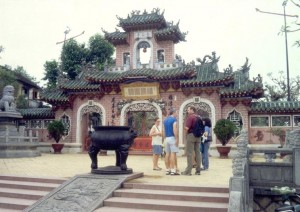
It served as a religious and intellectual centre where Champa kings were crowned and buried. In 1999 it was named a UNESCO World Heritage site. Hoi An also has a beach area where you can relax for a day or two and enjoy the sandy beach.
Danang:
The 5 peaks of the Marble Mountains are said to represent the 5 elements of water, wood, fire, gold and earth. Here you can explore 3 main grottoes which have been transformed into carved Buddhist sanctuaries. It is handy to take a torch with you to see the carvings and to see where you are walking when entering the caves.After the caves, you can take photos of the views
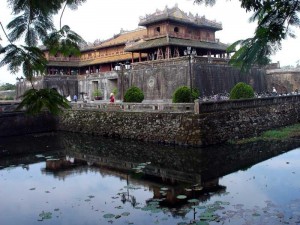
from the small pagoda site before heading on to China Beach which is popular amongst travelers. There are small beach cafes where drinks/ snacks can be bought and you can walk or relax on the sands.
Small fee applies to enter the caves site.
Hue:
Hue is intimately connected to the imperial Nguy?n Dynasty, based in Hue, who ruled from 1802 to 1945, when the Emperor Bao Dai abdicated in favor of Ho Chi Minh’s revolutionary government. The city went through tough times during the Vietnam War, when it was conquered by the Viet Cong and held for 24 days, during which the VC slaughtered around 1,000 people suspected of sympathizing with the South, and then subject to an American
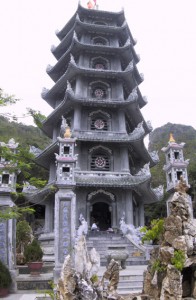
bombing campaign to retake the city.
Imperial Citadel
The former imperial seat of government and Hue’s prime attraction, this is a great sprawling complex of temples, pavilions, moats, walls, gates, shops, museums and galleries, featuring art and costumes from various periods of Vietnamese history. Thanks to its size, it is also delightfully peaceful – a rare commodity in Vietnam.
Hue’s weather is infamously bad: the Truong Son Mountains just to the south seem to bottle up all the moisture, so it’s usually misty, drizzly or outright rainy.
Thien Mu Pagoda
(4km) – perched on a bluff over the river and housing some very fine gold and silver Buddha images. The Thien Mu Pagoda overlooks the Perfume River and is the official symbol of the city of Hue. Thien Mu means “elderly celestial woman”, and refers to an old legend about the founding of the pagoda. Brimming with opportunities for great photos.
Phu Bai Airport
is a must-see if you are interested in the war. The airport was a dirt strip during the Indochina War. Then, during the Vietnam War, an American garrison was assigned there and built up the airport with concrete bunkers, a paved airstrip, and a few other luxuries. The airport was vital in keeping Hue supplied during the Eastertide Offensive of 1972 when “Charlie jumped the line”. The airport retains the original buildings built by the Americans; however, they have been retrofitted for use by the Vietnamese.
The Hoi An/Danang/Hue area is popular with tour companies and the trip usually tskes 4 to 5 days. Next we move up north.

He wanted a driver who was also a guide.
cum /ko?om/ – Combined with; also used as.
Thanks Dancebert….. now I know
Hi, can you recommend any reliable driver cum guide ? I am planning a 5 days, Danang-Hue-Hoi An-Myson-Danang. Thanks.
Not exactly what a cum guide is but I have heard the term used by indians. I am sorry that I cannot recommend a local person. I have met a few easy riders from there, but am unsure about their work habits. You might do best top ask one of the tour organizers that get promoted a lot on the Trip Advisor forums.